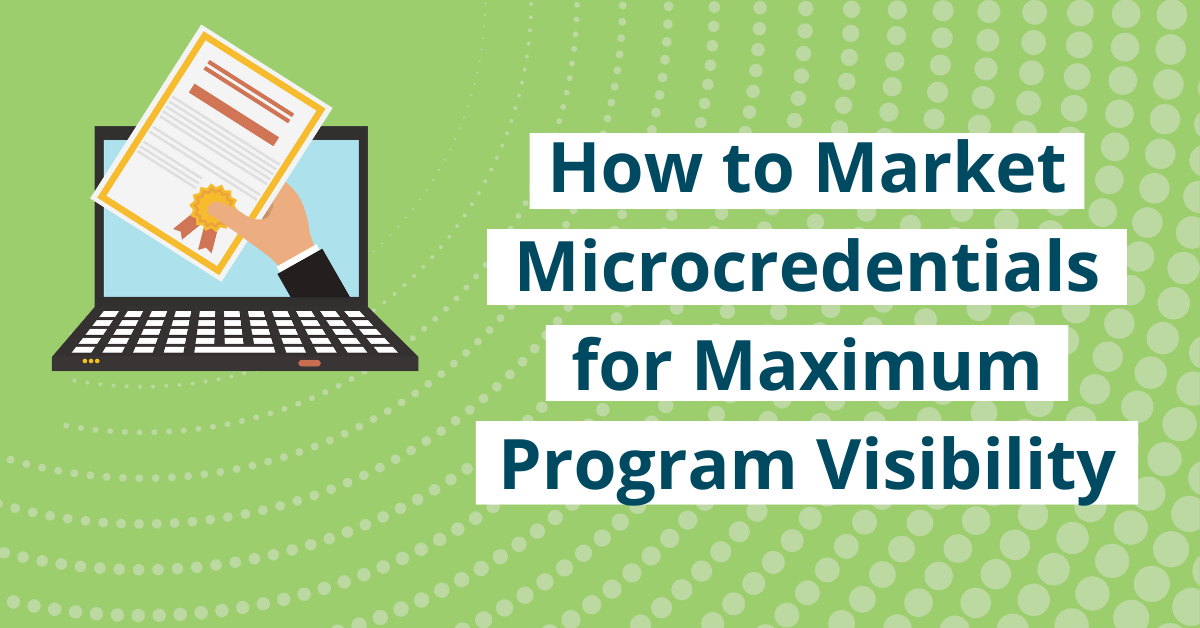How to Market Microcredentials for Maximum Program Visibility
May 19th, 2025 by
Key Insights
- Microcredentials are on the rise as adult learners, career changers, and working professionals seek faster, more affordable ways to gain in-demand skills.
- Unlike traditional degrees, microcredential enrollment funnels are short, fast-moving, and often self-directed. Learners may enroll within days, not months.
- Messaging that resonates with microcredential audiences emphasizes job relevance, flexibility, and immediate outcomes, rather than campus life or long-term learning.
- A strong cross-channel strategy, spanning SEO, paid ads, social, and email, is essential to reach today’s learners where they are and convert interest into action.
If your institution is offering microcredentials but struggling to fill seats, the issue might not be the program. It may be the marketing.
Microcredentials are short, skills-based credentials built for speed, flexibility, and career impact. They appeal to learners seeking advancement without the commitment of a full degree. To meet rising market demand, many institutions have expanded non-degree offerings to accommodate microcredentials and stay competitive.
According to Coursera’s 2024 Micro-Credentials Impact Report, 51% of higher ed leaders globally now offer microcredentials as part of their curricula.
Yet many are still applying degree-style marketing to a very different kind of learner.
Microcredential audiences move quickly. They prioritize outcomes over campus life and expect easy, immediate access to information. Reaching them requires a distinct, streamlined strategy that reflects how they search, decide, and enroll.
To boost your visibility and connect with these learners, follow these best practices for marketing your microcredentials.
Why Are Microcredentials Gaining Popularity?
Shifting demographics are reshaping higher ed
The traditional college-aged population is declining, creating enrollment challenges for institutions that have long relied on recent high school graduates. As the demographic cliff approaches, colleges and universities are looking to expand their reach to a new target audience, especially adult learners, career changers, and working professionals seeking practical options.
Millions are seeking an accessible path forward
According to UPCEA, more than 40 million adults in the U.S. have some college credit but no credential. Many of these individuals face external pressures (full-time employment status, financial strain, and family responsibilities) that make returning for a traditional bachelor’s degree difficult. Microcredentials, especially affordable and stackable ones, offer a flexible alternative for advancing professionally.
Economic pressures are driving new priorities
Over the past few years, rising education costs and mounting student debt have changed how people evaluate their learning investments. Many learners now prioritize programs that are affordable, low-risk, and lead to near-term career benefits. Microcredentials check all three boxes, offering focused, skill-based continuing education without the long-term commitment of a degree.
Employers are hiring for skills, not just degrees
Employers are increasingly prioritizing job-ready skills over traditional credentials. Microcredentials allow learners to gain and showcase specific, in-demand abilities that align with job market needs. Morning Consult research found that 81% of employers believe they should consider skills versus degrees when hiring. In many industries, demonstrable competencies are more valuable than academic transcripts.
Marketing Microcredentials vs Traditional Degrees
Marketing funnel differences
Microcredentials attract a different kind of learner, which means the path to enrollment also looks different. While traditional degrees involve extended timelines and multiple stages of engagement, microcredentials often require quick, outcome-driven decisions.
Traditional degree funnels typically involve:
- Long consideration periods, often spanning several months to a year
- Fixed application windows and admissions cycles
- Emphasis on relationship-building, exploration, and multiple touchpoints before enrollment
- Decisions influenced by long-term academic or personal goals
Microcredential funnels, by contrast, are defined by:
- Short decision-making windows — learners may enroll within days of discovering a program
- Rolling or frequent start dates that demand consistent promotion
- Higher expectations for fast outcomes, affordability, and convenience
- Learners motivated by immediate career needs, not long-term campus experiences
The enrollment process also plays a role. Some microcredential offerings are self-serve, allowing learners to register and start immediately without applying. Others still involve an application or review process. Knowing which type you’re marketing, application-based or on-demand, will shape how you message urgency, availability, and next steps.
Marketing messaging differences
Microcredential learners are goal-oriented, and your messaging needs to match that mindset. Unlike traditional students who may be drawn in by campus culture or the promise of a four-year journey, microcredential prospects are focused on immediate, practical learning outcomes.
Traditional degree marketing often emphasizes:
- Institutional reputation and academic prestige
- Campus life, student community, and support services
- Long-term growth and personal development
- Deep subject immersion over multiple years
This messaging supports a slower decision cycle where students take time to explore, attend events, and speak with admissions counselors.
Microcredential marketing requires a different focus. Your content should highlight:
- Clear career relevance and targeted skill development
- Fast, flexible online learning formats that fit into real life
- Tangible ROI, like job advancement, new credentials, or salary increases
- Social proof and real-world outcomes through testimonials or employer partnerships
Concise, career-focused messaging is key to building trust and driving action, especially when your audience is ready to move.
Since many microcredential learners bypass traditional touchpoints like info sessions or one-on-one meetings, your digital content must do more heavy lifting. Messaging across your website, ads, and email campaigns needs to quickly answer core questions such as: Is this relevant to my goals? How quickly can I start? What will this do for my career?
Aligning Your Microcredential and Graduate Program Marketing
To market microcredentials effectively, you need to understand how they relate to your existing graduate programs. Are they meant to stand alone, or are they part of a larger academic pathway?
Start by defining the relationship
Clarifying the purpose of each offering helps avoid mixed messaging and ensures that your marketing reflects the learner’s intent.
Microcredentials often appeal to learners exploring a field, building targeted skills, or seeking quick career advancement. These are typically short-term career goals. Graduate programs, by contrast, attract those ready to invest in long-term academic or professional growth.
Connect the path when it makes sense
If both options fall under the same subject area, consider framing your marketing around the learner’s goals rather than the credential type.
Positioning microcredentials as an on-ramp, not just an alternative, helps fuel engagement across all your program types. It reinforces long-term value while meeting learners where they are now.
For example: Instead of promoting a “Digital Marketing Microcredential” and an “MS in Marketing” as separate tracks, position them together as “Marketing Programs for Every Stage of Your Career.” This approach helps prospective students understand how various educational programs fit into a broader professional path.
There’s still value in marketing each program individually, but building cross-awareness can strengthen both funnels. If your microcredentials are stackable, make that progression clear in your messaging and visuals. Show how learners can move from a single course to a certificate or a digital badge, and eventually to a master’s degree if they choose.
How to Market Microcredentials With a Cross-Channel Approach
To reach today’s fast-moving, outcome-driven students, you need a coordinated presence across search, social, and email. Microcredential learners don’t follow a single path to enrollment, so your marketing strategy shouldn’t rely on a single channel.
SEO
Roughly 68% of online experiences begin with a search engine, according to Ahrefs. For prospective learners, that makes SEO the natural first touchpoint, and a critical one. Whether they’re comparing options, looking for a specific skill, or exploring career next steps, your program pages need to rank and resonate.
Start by creating dedicated pages for each microcredential, and structure them around what your audience cares about most:
- What new skills they’ll gain
- How the program is delivered (online, hybrid, self-paced)
- How long it takes and how much it costs
- Who’s teaching it and what kind of outcomes students can expect
Include strong, clear CTAs and support your value proposition with testimonials, employer recognition, or career placement stats when available.
To improve visibility, optimize for long-tail keywords that reflect specific intent, such as:
- “How to earn a microcredential in [topic]”
- “[Topic] online course for working professionals”
- “Affordable short-term certificate programs in [industry]”
You should also support your SEO efforts with blog content that answers common questions and reflects search intent. Topics like career outcomes, comparisons to bootcamps, or time and cost advantages can help draw in qualified traffic while positioning your institution as a helpful resource.
Paid search
While SEO builds long-term visibility, paid search helps you capture demand in the moment, especially from learners who are ready to take the next step. By targeting high-intent keywords, you can reach prospective students actively searching for fast, flexible learning options.
Focus your campaigns on search terms that reflect urgency and career motivation, such as:
- “[Topic] certificate online”
- “Short course in [field]”
- “Learn [skill] online”
- “Career-focused [topic] course”
Ad copy should speak directly to what matters most to microcredential learners:
- Career outcomes: What can they do or achieve after completing the course?
- Time to completion: Use specifics like “Gain skills in 6 weeks” to set clear expectations
- Cost transparency: Highlight affordability with phrases like “Only $399” or “Job-ready training for less”
- Learning format: Reinforce convenience with “100% online education,” “Self-paced,” or “Evening-friendly” messaging
When done well, paid search drives more than traffic. It drives action. Use your landing pages to reinforce the value promised in your ad, making it easy for learners to take the next step without unnecessary friction.
Paid social & display
Paid social and display advertising are powerful tools for expanding your reach and reinforcing program awareness. These channels connect you with prospective learners where they’re already spending time, whether they’re scrolling LinkedIn during a work break or browsing Facebook after hours.
Use platforms like LinkedIn and Meta to deliver tailored messaging that reflects where someone might be in their decision process:
Awareness
- Target by job title, industry, or interests to reach learners who may not yet know about your program
- Focus on big-picture benefits like career change, flexibility, or upskilling
- Use headlines like “Break into tech without a degree” or “Get ahead in healthcare. No long-term commitment required.”
Consideration
- Highlight program features: length, cost, format, and career outcomes
- Use short videos or carousels to showcase what learners can expect
- Highlight learning from experienced faculty who double as industry leaders
- Keep messaging focused and benefit-oriented: “Gain job-ready skills in just 8 weeks” or “Fully online, on your schedule, courses”
Decision
- Reinforce urgency with enrollment deadlines, limited-time offers, or next steps
- Use testimonials, student quotes, or employer recognition to build trust
- Retarget those who’ve visited your website or interacted with earlier ads but haven’t yet enrolled
Well-timed, well-targeted social and display ads help keep your microcredential programs visible and relevant, especially for learners who need a few reminders before they’re ready to commit.
Organic social
Organic social media marketing plays a long game. It helps your institution stay present, build credibility, and create meaningful connections with prospective learners over time.
With social search on the rise, platforms like LinkedIn, Instagram, and Facebook are becoming key discovery tools for those exploring career paths and educational opportunities. A strong presence here highlights the real value of your microcredential programs through authentic, relatable content.
Share content that reflects learner goals, outcomes, and lived experiences:
- Career wins: “How I landed a new job three months after earning my certificate”
- Industry insights: “Top 3 skills employers want in [field] right now”
- Behind the scenes: “What it’s like to take this course as a working adult”
Short-form videos, alumni spotlights, and faculty features give your program dimension and authenticity. Focus on flexibility, support, and real-world impact, all core themes that resonate with busy professionals looking to level up.
A thoughtful organic social presence reinforces the credibility of your program and helps prospective learners see themselves in the experience you offer.
Email nurture campaigns
Email marketing is one of the most effective ways to keep prospective learners engaged after their initial inquiry. With the right segmentation and sequencing, email nurture campaigns guide students from interest to enrollment, while reinforcing the value of your microcredential programs along the way.
Start by segmenting your audience based on what matters most: program interest, learner intent, or stage in the decision-making process. Then build a sequence that delivers timely, relevant content with a clear next step.
A sample 3-email sequence might look like this:
- Email 1: Welcome + program overview: Introduce the microcredential, who it’s for, how long it takes, and how it’s delivered. Reinforce accessibility and flexibility.
- Email 2: Career outcomes + student story: Focus on the real-world value. Share a testimonial or brief case study that shows how past learners applied the credential to advance their careers.
- Email 3: FAQs + next steps: Address common questions about cost, deadlines, or course requirements. End with a strong, direct CTA that encourages action.
Calls to action like “Start now,” “View your course options,” or “Get your questions answered” can make a big difference when timed right. The goal is to stay helpful, human, and focused, offering just enough information to move learners forward without overwhelming them.
Turn Microcredential Interest Into Enrollment
A successful microcredential marketing strategy doesn’t exist in a silo. It works best when it’s part of a larger, student-centered, cross-channel approach.
From SEO and paid search to social and email, your campaigns should reflect how today’s learners search, engage, and ultimately make decisions.
Search Influence is a higher education digital marketing agency that helps institutions market everything from short-term certificates to full degree programs. We know how to tailor strategies based on learning format, audience intent, and funnel stage, so you can meet prospective students with the right message at the right moment.
Not sure where to begin? Let’s start by evaluating what you’re already doing.
See where your microcredential marketing stands
Our Self-Assessment for Higher Education Marketers includes seven proven strategies to strengthen your campaigns, covering everything from program pages and CTAs to video, lead generation, and remarketing.
It’s designed to help your team build full-funnel, cross-channel campaigns that turn awareness into enrollment and position your institution for long-term success.
Download the self-assessment and start identifying your next best opportunities today.





